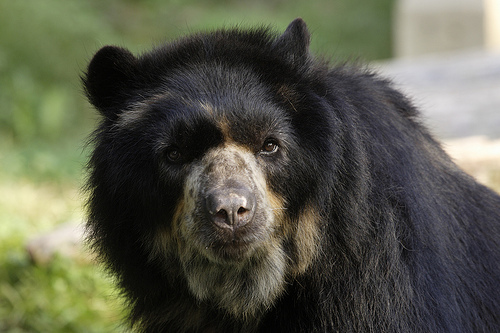Andean Bear Dies at National Zoo
Nikki Underwent Treatment for Cancer of His Jaw
Nikki, the 20-year-old male Andean (or spectacled) bear at the Smithsonian's National Zoo was euthanized Aug. 6. A final pathology report will provide more information. Keeper and veterinary staff had been intensely managing his health over the past year, and his condition began to rapidly decline in the last three weeks.
Nikki developed an ulcer on his lower jaw in 2011. When keepers noticed that it was not healing, National Zoo veterinarians examined the bear and obtained a biopsy of the ulcer. The test results revealed that the ulcer was an aggressive squamous cell carcinoma, a type of cancer. Zoo veterinarians, with the help of consulting veterinary dental and surgical specialists, removed the affected section of Nikki's jaw. Based on consultation with a veterinary oncologist, the bear was started on oral chemotherapy to slow any potential regrowth of the tumor. Nikki did well for a year. Unfortunately, the carcinoma spread to other areas of his body.
It's always hard to lose an animal we care so much about, and we feel very lucky to have had Nikki as part of the National Zoo family, said Craig Saffoe, curator of Great Cats and Bears at the National Zoo. He was a really cool bear gushing with personality, which made him a favorite amongst visitors and keepers alike.
Nikki came to the Zoo five years ago severely overweight and was put on a new weight-loss plan developed by the Zoo's nutritionists and maintained by his keepers. Nikki was able to safely lose almost 200 pounds in a year—boosting his physical fitness and ability to be considered for breeding. In January 2010, Nikki sired two cubs, Bernardo and Chaska. They were the first of their species born at the National Zoo in 22 years and the only surviving cubs produced in the Association of Zoos and Aquariums' Andean Bear Species Survival Plan since 2005.
In general, Andean bears live to be 20—25 years old in human care; not much information is known about the species in the wild. They are listed as vulnerable on the International Union for Conservation of Nature's Red List of Threatened Species, and it is estimated that there are only 2,000 left in the wild. They are the only surviving member of the short-faced bear subfamily. They are South America's only bear species, and as their name suggests, they live in the Andes mountain range from western Venezuela south to Bolivia, with sightings reported from eastern Panama and extreme northern Argentina.
The Zoo currently has two Andean bears—Billie Jean and Chaska. Due to renovation construction in the American Trail area, the Andean bear exhibit is only accessible to visitors on weekends. Regular viewing hours will resume when American Trail opens Sept. 1.

